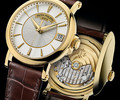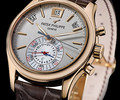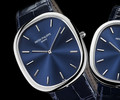Patek Philippe World Time watch Ref. 5131
BASELWORLD 2008
| Rating: 69 %1000 with 442 votes |
 3850
on July 10, 2009 at 07:04 p.m..
3850
on July 10, 2009 at 07:04 p.m..
 Yes a lot 3
Yes a lot 3  Not so much 0
Not so much 0
- Summary
- Patek Philippe World Time watch Ref. 5131
- Specifications Patek Philippe World Time watch Ref. 5131
Patek Philippe Geneva - April 2008
The watch as a work of art
At this year’s Baselworld, Patek Philippe is unveiling the World Time watch Ref. 5131. It is a debut that will charm many people for many different reasons. Its mechanism for the permanent display of all 24 time zones and its amazingly fast adjustability to any local time, constitute a technical coup that will appeal to everyone who admires useful complications. In turn, its cloisonné enamel dial will delight connoisseurs of the art of enamelling. Finally, watch collectors will be pleased to see this particular type of timepiece – at international auctions, its predecessors meanwhile fetch astronomical prices – back in the Geneva workshops’ standard collection.
24 time zones with a glance at the wrist
Patek Philippe’s multiple time zone watches belong to the category of so-called useful complications. They serve their owners well with practical functions of relevance in contemporary everyday life. A World Time watch indicates the hour in all major cities at a glance. The local time indicated by the hour and minute hands applies to the location on the city disk that is directly aligned with 12 o’clock. The crown is used to set the correct time in conjunction with the 24-hour ring, so a distinction can be made between 4 am and 4 pm. Now, switching from one time zone to another is accomplished simply by pressing the button at 10 o’clock. Every time it is pressed, the hour hand will advance by one hour while the city ring and the 24-hour ring will rotate counterclockwise by one hour (equivalent to one time zone). Pressing the button 24 times emulates a trip around the world and a return to the point of departure.
This mechanism was devised by the gifted Geneva watchmaker Louis Cottier in the early 1930s. He offered his invention to Patek Philippe first and in 1959, the company protected it with Swiss Patent No. 340 191. Subsequently, the ingenious inventor created another mechanism for the Genevabased manufacture. It was able to display two time zones simultaneously. In the late 1990s, this second invention inspired the development of the Calatrava Travel Time. With a solution patented in 1999, Patek Philippe further optimized the caliber 240 HU (Heure Universelle = World Time) movement by totally isolating the World Time mechanism with the city and 24-hour rings from the going train of the watch. Thus, when the mechanism is switched from one time zone to the next, the accuracy of the movement and the progression of the minute hand are not affected. Caliber 240 HU is an ultra-thin self-winding mechanical movement that features a 22K gold mini-rotor recessed in the plate. It beats with a frequency of 21,600 semi-oscillations per hour (3 Hz). In 2000, Patek Philippe used this movement to reintroduce the World Time watch into its standard collection; it proved to be an instant bestseller.
Watches for connoisseurs and collectors
The exclusivity of these complications is no doubt the principal reason why Patek Philippe’s 1940s and 1950s World Time watches fetch higher prices at international auctions than any other wristwatches. Bids in the magnitude of several hundred thousand Swiss francs are now the rule, but the record today is still held by an early platinum model that changed hands in 2002 for the fantastic sum of 6.6 million francs (in excess of US$6 million).
Models showcasing a small, hand-made cloisonné enamel miniature in the center of the dial are particularly coveted. The eclectic motifs range from clusters of palm trees to solitary lighthouses, but the most popular ones are colorful, stylized world maps because they best match the purpose of the timepiece. Such a map also adorns the dial of the new Patek Philippe Ref. 5131, finally giving collectors the renewed opportunity to find a watch in this category within the company's current portfolio.
Due to the complex processes involved in the making of cloisonné enamel dials, only a small number of Ref. 5131 watches will be available each year.
The art of cloisonné enamelling
In addition to Geneva enamel and champlevé enamel, cloisonné enamel is one of the three classic techniques traditionally used to decorate watches and dials. The motifs are always silhouettes whose contours define the shapes of the “cloisons” (French for partition, or cell) that ultimately contain the differently colored zones of the finished enamel opus. A characteristic shared by all enamelling techniques is the stunning brilliance of the colors: unlike paintings that use conventional pigments, they do not fade and retain their luster for centuries.
A cloisonné enamel piece begins as a wafer of copper or gold into which the contours of the motif are scored by hand. Subsequently, the lines are retraced with very thin, flattened gold wire. Like a dainty ribbon standing on its edge, the wire is bent with tweezers to follow the contours and then secured in a first firing; eventually, the entire drawing is composed of a number of cloisons which now need to be filled with the enamel mass. Enamel consists of finely crushed glass ground to powder. The addition admixture of various metal oxides produces the colors when the glass is melted. After the powder has been filled into the cloisons, the work of art can be fired in a special furnace at temperatures between 850 and 900°C. To prevent distortion, the reverse side of the wafer must also be coated with a layer of enamel, the so-called: “contre-email”.
Because the metal oxides added to the powder can change their color at different temperatures, enamel work can involve numerous firings passes. The end result is a colorfully arrayed glass motif from which the gold wires forming the cells protrude. These wires are then polished down to the level of the glass layers, and in the final phase, the entire work of art is protected by the fondant, a colorless, highly transparent layer of enamel applied in a last firing process. At the end of every firing pass, the enamel miniature must be allowed to slowly cool to room temperature in a precisely controlled manner. Otherwise, thermal stresses could cause the hard, fused glass to crack.
Thus, The art of cloisonné enameling not only requires virtuosity and a highly developed sense of aesthetics. The artisans who master it must also be fully aware of the technical, physical, and chemical processes involved in preparing, mixing, applying, and firing the enamel mass. Until the early 20th century, cloisonné enameling, champlevé enameling, and miniature painting according to the acclaimed Geneva enameling traditions were precious skills needed to embellish watches and other luxury objects. Elsewhere, the tradition sank into oblivion, but Patek Philippe never stopped crafting beautifully decorated enameled wristwatches, pocket watches, and table clocks featuring lavish decorations based on venerable enameling techniques. After all, an art must be preserved in order to ensure a successful future.








